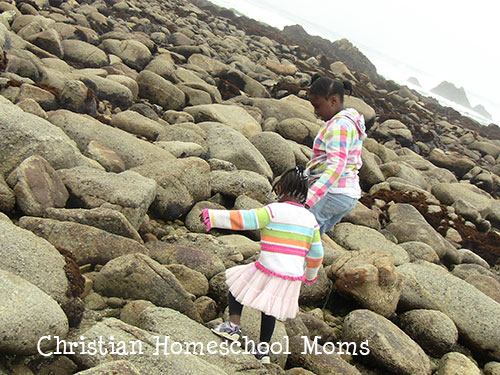advertisement
The following post is from Demetria of Christian Homeschool Moms:
advertisement
Once you start to homeschool preschool, you’ll realize just how much fun and relaxation can (and should) come into play! Preschool should be all about fun learning, and it can be a rewarding experience for you and your kids.
Teaching the preschool age has always been a lot of fun to me because I enjoy the whimsical and curious stage that three’s and four’s experience. Not too long ago I had a preschooler whom I slowly introduced into our homeschool.
Here are some guidelines that have helped me to homeschool preschool
Plan out your curriculum.
Take some time to plan out what you’d like your preschooler to learn. Think about how to add in some basic math concepts, phonics, and fun science or cultural studies into your day. You can also integrate music and art as well as faith studies. Keep in mind that you’re not attempting to go overboard here. You just want a general idea of what you’d like to experience together with your child.
Gather materials.
The web is a vast array of resources. Simply doing a google search for “preschool curriculum” will yield you plenty of results. I would recommend that you start by finding child development-friendly publishers and companies and see the types of resources they offer. You may be pleased at the results you come across. Here is a short list of preschool-friendly curriculum publishers and materials providers:
- Educents– Though not a preschool-only vendor, you’ll find loads of great buys (and sometimes freebies) on preschool materials and curriculum. Join their mailing list and keep an eye for bargain prices on preschool curriculum that may work for you.
- Timberdoodle- Offers you the flexibility of building your own unique curriculum by grade/age level (including preschool). They also offer complete kits to take the pressure off building it yourself. They offer educational materials from a variety of publishers, often with competitive pricing.
- Lakeshore Learning– Get educational supplies, equipment, furniture, and curriculum according to grade level all in one spot.
- ABC Mouse – A virtual online curriculum for preschool through kindergarten. My daughter enjoyed learning phonics, math, science, art, and music on this site. Learning is engaging and fun with ticket rewards and incentives for your child’s progress.
- School Zone– Offers a variety of workbooks, flashcards, and software for your student. Just select the appropriate grade level and you’ll have a blast looking at all the options.
- Mother Goose Time– A set of themed curriculum sent to you for a year of ideas and concrete materials to help you enjoy exploring music, art, and logic games with your child.
- Teachers Pay Teachers– This is also another great option for picking up those unit studies and activity sheets!
- Currclick– Unit studies, lapbooking, notebooking pages, you name it. It’s all here at Currclick, and you’re bound to find something fun for your preschooler.
Dianna also provides a list of preschool learning games that you might like to search through.
You can also create your own materials for fairly cheap. I created a flannel board for less than $3 using a poster board, a hot glue gun, and flannel material.
Set aside shorter segments of time.
Teaching preschool is really about enjoying life. Use the resources you’ve gathered and apply them to your daily life with your child. Make it a useful, meaningful experience. But remember- your three, four, or five-year old child needs lots of time to enjoy life at their own pace. I recommend lots of play with very short segments of seatwork, if any at all. Shorter learning times always works best for younger kids who need to get the wiggles out and have time to run and play freely.
I also like to divide my preschool mornings up into interest-based centers. For example, although my room was fairly small I decided to categorize different sections of our homeschool room into activity hubs such as: phonics/reading center, language arts center, math center, etc. Outside we could easily “do” science or explore nature. In the kitchen we rolled up our sleeves and cooked together. At our dining room table, we spread newspapers and did art with paints, brushes, glue, and other art mediums.
Sometimes we started our morning with a short bible lesson and memory verse. We also practiced learning numbers and counting, days of the week, months of the year, telling time, and the alphabet during this time, using our flannel board or activity board.
Here’s a video showing an example of our preschool circle time. Keep in mind there is no right or wrong way to approach preschool at home. These are your kids, so do what feels naturally to your family.
Focus on age-appropriate skills.
Don’t focus too much on seatwork, although an occasional worksheet never hurts, if your child likes to do them. If you’re certain your child is ready to begin learning phonics and some basic math, go ahead and plug in some seatwork, but make it light. My advice would be to make learning fun. You can present letters and letter sounds, reading skills, counting, patterns, and writing through a variety of ways. Add in a good dose of story-telling, singing songs together, fun arts and crafts, and a whole day of play.
Allow lots of free time.
Kids need lots of free time to enjoy free time. In the early years, when you choose to homeschool preschool, it’s important to give yourself the freedom to allow your kids to enjoy learning in a casual and fun atmosphere. I’ve learned that exploring, cooking together, tending a garden, investigating magnets, and learning home chores are all great ways for little ones to enjoy learning without the label of “school.”
Go on field trips together.
Of course, any outings you go on together can count toward field trips, and open up your child to seeing the world through fresh eyes. Take a nature walk, visit the aquarium or the zoo, go berry-picking. Take trips to the library. The world is your limit!
Schedule play dates.
At this age, preschoolers love to be with other kids for fun and play. It’s great if you can coordinate play dates with other moms of preschoolers. Also, be looking for local park days and meet-ups of moms with preschoolers, such as the MOPS organization. Find friends at church or even at homeschool park days, and you’ll see that many parents with older kids also have preschool-aged children, which is a great way to connect.
Do you currently homeschool preschool? What are some of your homeschool choices for this age group?
Other Preschool Posts You Might Enjoy:
- Invitations to Play: Easy Ways to Help Your Child Develop Their Imagination
- Shape Identification and Counting Worksheet Printable
- Printable Learning Activities for Preschoolers
- Preschool Science Experiments
- Printable Shapes Resources for Preschoolers
- Number Writing and Matching Game for Preschoolers
- Shapes Themed Printable Packet
- 25 Activities for Preschoolers While Their Siblings are Working on School
 |
Demetria is a homeschooling mompreneur and blogger residing in beautiful California with her Navy reservist husband, 2 kids, and a Shih Tzu named Shaggy. She’s also a podcast consultant, mompreneur coach at Web Success Coaching, and founder of Christian Homeschool Moms. When she’s not blogging, teaching, or coaching, you might find her walking along the beach for inspiration or writing a song at piano. You can connect with her by Google+, You Tube, Twitter, and Pinterest. |
Join 40,000+ Other Awesome People
Subscribe to the Real Life at Home weekly newsletter to get our latest content, exclusive free printables, learning activities, and ideas for celebrating with your kids all year


Leave a Reply